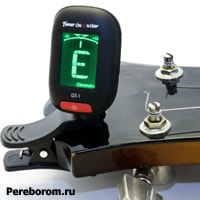
Six-string guitar tuning. 6 ways to tune and tips for beginner guitarists.
Contents

Introductory information
Even before you start playing your first passages, chords and songs on the guitar, it is worth learning how to tune it. Then the guitar will sound even, all harmonies will be in harmony with each other, chords and scales will be exactly what they should be. There are several ways to tune the strings of a six-string guitar, and that’s what this article is about. It is worth noting that almost all the methods listed below are suitable both for those who want to set the instrument to the standard tuning, and for those who like to build it in Drop or lower, but based on the fourth sound.
Basic Concepts
The pegs are where the strings are attached and need to be turned to tune them.
Harmonics are overtones that can be played by simply touching the strings at the fifth, seventh and twelfth frets. In order to play them, you just need to put your finger on the string near the nut, while not pressing it, and pull. A very high sound will be heard – this is the harmonic.
A tuner is a special program that reads its amplitude by the vibration of air around a string and determines the note it gives.
How to start tuning a six-string guitar?
If you are a supporter of simple ways – then with the purchase of a tuner. You can not go broke on expensive devices, but buy a simple “clothespin”, or a microphone version – they are quite accurate, so there should be no problems with tuning.
Standard guitar tuning
Standard tuning is called standard tuning because that is how most classical guitar pieces are played. It is very easy to clip most of the chords in it, so modern musicians mostly use either it unchanged or its note distribution logic. It looks like we wrote above:
1 – denoted as E 2 – designated as B 3 – denoted as G 4 – denoted as D 5 – designated as A 6 – denoted as E
All of them are tuned to a fourth, and only the fourth and fifth form a reduced fifth between them – a different interval. This is also due to the fact that it is easier to perform some pieces this way. It is also important when tuning a guitar by ear.
Ways to tune guitar strings
Fifth fret method

1. So, hold the second string at the fifth fret and at the same time pull it and the still open first. They should sound in unison – that is, give one note. Twist the tuning pegs until you hear the sound you want – but be careful, because you can overdo it, and you will have to change the strings on the guitar.
2. After that, on the fourth, hold the third string, and it should sound the same as the open second. The same thing happens with the tuning of the third through the second – that is, hold down the fourth fret.
3. All other strings should sound the same at the fifth fret as the open string before being tuned.
And the most interesting thing isthat this principle is preserved even if you lower the entire system half a step lower, or even one and a half steps. However, you should not rely completely on hearing – but you can tune the instrument without a tuner.
Tuning a guitar with a tuner

Phone setup

Using guitar tuning software

Tuning flagoletami

As mentioned above, the harmonic can be played by touching the string with the pad of your finger just above the fret, without pressing it down. You should end up with a high, non-rattling sound that doesn’t go away when you put your finger down. The trick is that certain overtones should sound in unison on two adjacent strings. One way or another, if the guitar is completely out of tune, then one of the strings will still have to be tuned by a tuning fork or by ear.
The principle is as follows:
- The base is a harmonic at the fifth fret. It must always be used.
- The harmonic on the fifth fret of the sixth string should sound in unison with the harmonic on the seventh fret of the fifth.
- The same applies to the fifth and fourth.
- The same applies to the fourth and third
- But with the third and second question a little different. In this case, on the third string, the harmonic should be played at the fourth fret – it will be a little muffled, but the sound will still go on. For the second, the process does not change – the fifth fret.
- The second and first strings are tuned in the standard fifth-seventh ratio.
Tuning via online tuner
In addition to programs, a lot of online services appear on the network for tuning a 6-string guitar, freeing you from the need to download third-party software. Below is one of these online tuners with which you can easily tune your instrument.
What should I do if the guitar is out of tune?
In fact, there may be a lot of problems hiding in this issue. First of all – remove your strings and tighten the pegs with a screwdriver and a special wrench – it is quite possible that they have become loose and the tension quickly disappears for this reason.
In addition, the problem may lie in the tuning of the guitar neck – it may be overtightened, undertightened, or even screwed up. In this case, it is best to contact a guitar luthier rather than repairing the instrument yourself.
Instructions for every day. How to quickly tune your guitar
- Learn the musical notation for each string;
- Buy, download, or find a good tuner;
- Turn it on and pull the desired string separately;
- If the tension slider goes to the left, or down, then turn the peg in the direction of tension;
- If to the right or up, then turn the peg in the direction of weakening;
- Make sure that the slider is in the middle and shows that the string is tuned correctly;
- Repeat the same operation with the rest.
Conclusion and Tips
Of course, tuning a guitar through a microphone is the most accurate way to tune an instrument, and every guitarist should buy a tuner for this. However, it is still recommended to master at least one way to tune the instrument without a tuner and by ear – this way you will untie your hands if you suddenly forget the device at home, and you want to play the guitar.





